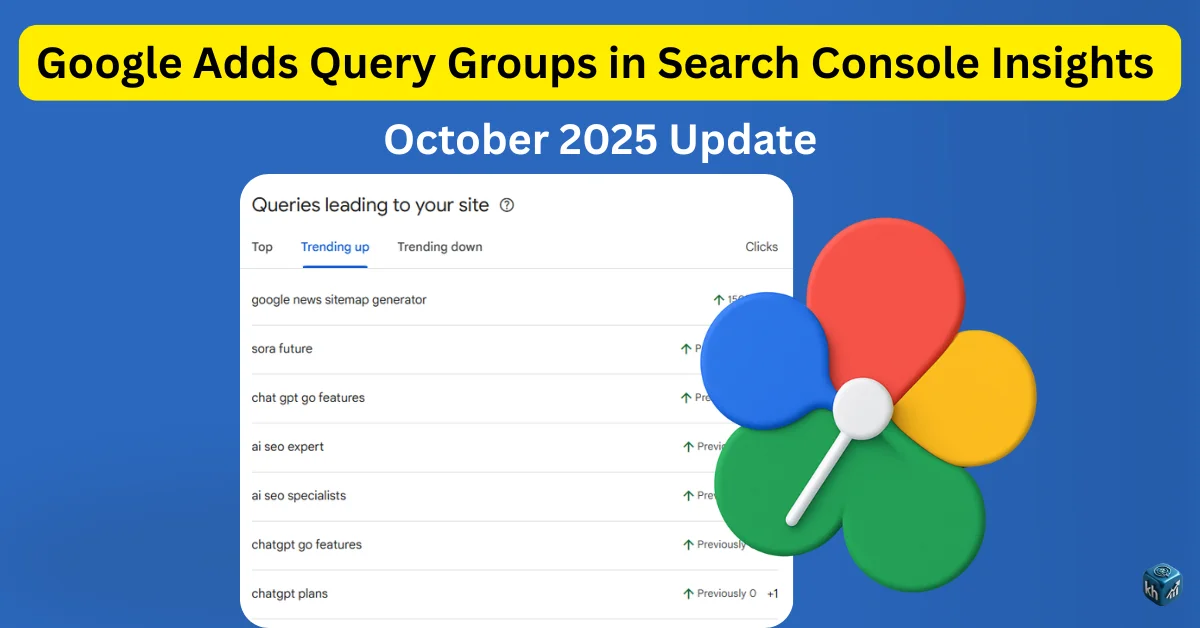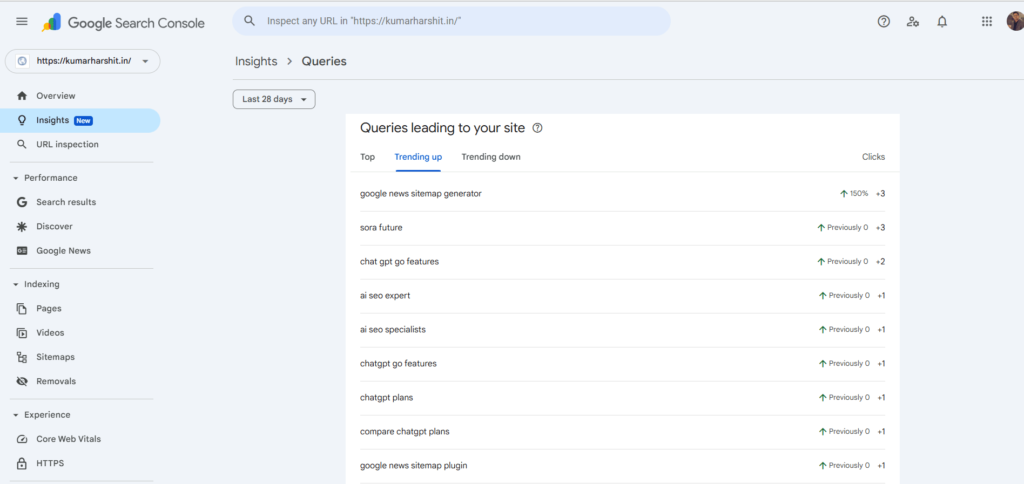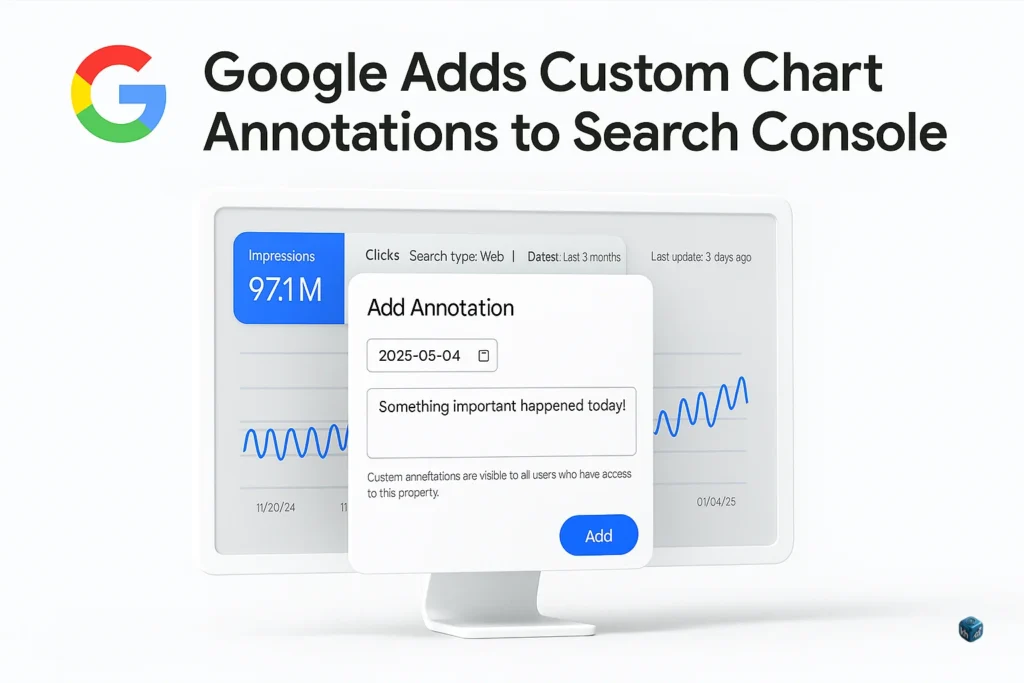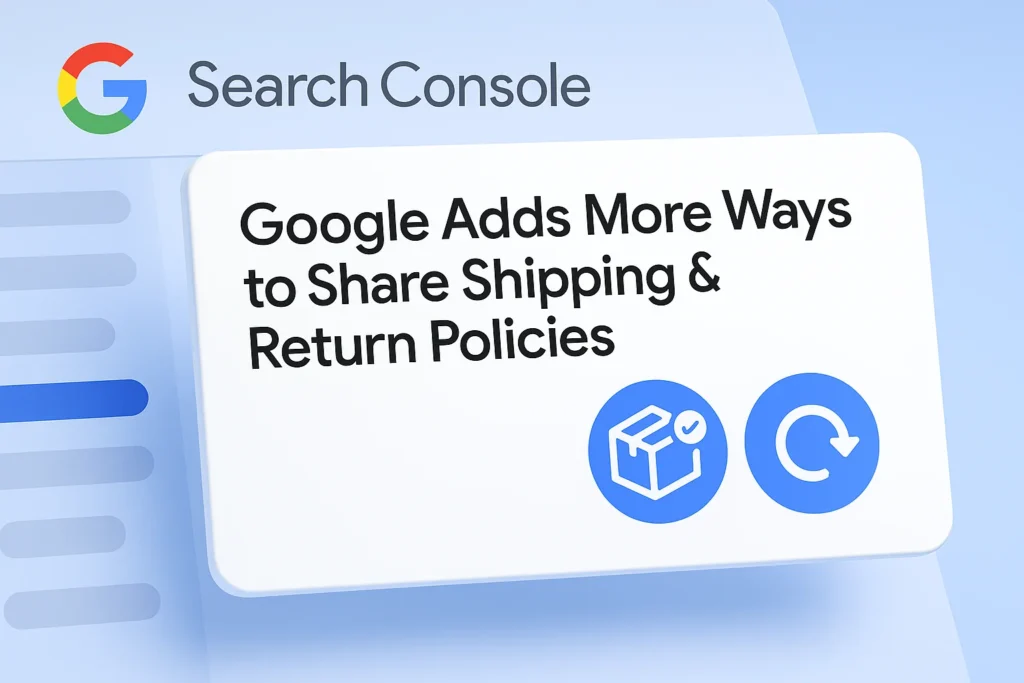Google Adds Query Groups in Search Console Insights (October 2025 Update)

On October 27, 2025, Google officially announced a new enhancement to Search Console Insights — the addition of Query Groups, a feature designed to help website owners, publishers, and SEO professionals better understand how users find their content on Google Search.
(Source: GSC Blog)
This update uses machine learning to organize similar search queries into logical intent-based groups, enabling site owners to analyze performance in a more intuitive way. For years, Search Console displayed query-level data line by line, which often overwhelmed users with hundreds of keyword variations. The new grouping system solves that problem by clustering related search phrases — helping SEOs see the bigger picture behind their site’s visibility.
🧩 What Are Query Groups in Search Console?
Query Groups are AI-generated clusters of search queries that share a common intent. For example, Google might group together:
- “AI SEO specialist,” “AI SEO expert,” and “SEO using AI tools”
- “Google News sitemap generator” and “news sitemap plugin for WordPress”
These queries differ in wording but share the same user intent — to find information or tools about AI-driven SEO or Google News optimization.
Each group is displayed in the Queries leading to your site card under the Insights section of Search Console, divided into three main tabs:
- Top: The most-clicked query groups during the selected period.
- Trending up: Groups that show significant growth in clicks.
- Trending down: Groups whose clicks have declined compared to the previous period.
This new AI-based grouping reflects Google’s ongoing effort to make Search Console Insights more actionable and less data-heavy, especially for non-technical site owners.

🔍 Where to Find Query Groups in Search Console
You can access Query Groups by visiting:
Search Console → Insights → Queries leading to your site
If your site qualifies (enough traffic and query volume), you’ll now see grouped terms instead of individual keyword rows. Clicking on any group takes you to the Performance report, filtered for all queries included in that group.
Your dashboard may look similar to this:
- Top queries: “news sitemap generator plugin,” “AI SEO specialist,” “Google news sitemap generator”
- Trending up: Queries showing rapid growth in clicks
- Trending down: Queries losing visibility or engagement
This new structure is currently visible in your site (https://kumarharshit.in/) as per the latest live screenshot — confirming early rollout for active verified properties.
⚙️ How to Use Query Groups Effectively
Google designed Query Groups to simplify decision-making by reducing keyword noise. Here’s how you can make the most of them:
1. Identify Intent-Based Opportunities
Instead of focusing on single keywords, analyze groups of intent.
For example:
- A group labeled around “AI SEO specialist” could indicate strong visibility for service-related searches — signaling that your SEO branding resonates with AI-related terms.
- Another group like “news sitemap generator” may show product-level discovery intent.
By understanding which topics or intents perform best, you can prioritize similar content, tools, or services.

2. Monitor “Trending Up” and “Trending Down” Queries
The “Trending Up” section helps identify emerging interest areas, while “Trending Down” flags potential declines.
- If a group is trending up, reinforce it with supporting blog posts or landing pages.
- If a group is trending down, investigate whether competitors, seasonality, or site changes are responsible.
3. Analyze by Region and Device
Query Group data connects with the Top Countries and Device filters within Insights.
For example:
- If “AI SEO specialist India” performs better on mobile in India, you may want to strengthen mobile-first content in that region.
- If clicks are high from the U.S. but engagement is low, localizing your messaging may help.
4. Cross-Link with Search Console Performance Report
Each Query Group can be expanded to see the exact queries included within it. This helps validate which phrases drive impressions, clicks, and CTR changes.
It also allows deeper analysis — such as keyword cannibalization or identifying where one URL serves multiple query intents.
🧠 Why Google Introduced Query Groups
Search Console already provides deep query data, but the insights often overwhelm users — especially non-SEOs managing small businesses. Google’s goal with Query Groups is to:
- Summarize complex data into meaningful patterns.
- Highlight content intent instead of keyword syntax.
- Improve discoverability of opportunities that align with user search behavior.
According to Google’s announcement, this grouping uses AI-powered pattern recognition to merge variations and synonyms. It’s similar to how Google’s ranking systems understand semantic meaning — grouping “buy running shoes” and “purchase sneakers online” as the same intent.
This feature marks another step in Google’s ongoing effort to make Search Console Insights a more intuitive storytelling tool — connecting data with business decisions.
📈 SEO Benefits of Query Groups
For SEO professionals, Query Groups bring several tangible advantages:
1. Better Content Strategy Alignment
By viewing grouped intent data, SEOs can create content that targets broader topics rather than isolated keywords. This mirrors Google’s shift toward topic clusters and semantic relevance, improving both visibility and topical authority.
2. Smarter Keyword Consolidation
Many sites accidentally create multiple pages for the same search intent (e.g., “AI SEO guide,” “AI SEO strategies,” “AI SEO techniques”). Query Groups reveal when queries overlap, helping reduce content duplication and focus link equity more effectively.
3. Simplified Performance Reporting
Instead of exporting hundreds of individual queries, marketers can now report grouped data to clients or management — making performance summaries clearer and easier to interpret.
4. Detecting Early Ranking Shifts
The “Trending up” and “Trending down” sections allow SEOs to catch ranking shifts early. If a group begins losing clicks, it might reflect:
- Reduced ranking positions for all related terms
- Increased competition from new content or SERP features
- Algorithmic devaluation of outdated pages
5. Enhanced AI-Driven SEO Optimization
Since Google’s grouping itself is AI-based, analyzing these clusters helps SEOs understand how Google’s own systems interpret topical relevance. You can refine content to better match this intent mapping.
🧭 Query Groups vs. Traditional Queries
| Feature | Traditional Queries | Query Groups |
|---|---|---|
| Focus | Individual keywords | Intent-based clusters |
| Analysis Depth | Granular but fragmented | Contextual and semantic |
| Ease of Use | Requires filtering and exports | Unified visual summary |
| Audience | SEO professionals | All site owners |
| Insight Quality | Keyword-level metrics | Topic and intent-level understanding |
🧩 Combining Query Groups with Other Search Console Insights
The new Query Groups work seamlessly with other Insights report cards, such as:
- Your content: Top-performing pages based on clicks and engagement.
- Top countries: Where your site receives the most impressions.
- Additional traffic sources: Clicks from Image Search, Discover, or News.
By comparing Query Groups with these metrics, you can link query intent → content type → region/device performance, creating a 360° SEO view of your site.
🧮 Practical Example
Let’s say your site ranks for terms like:
- AI SEO specialist
- AI SEO expert in India
- best AI SEO consultant
Google will now group them under a single “AI SEO specialist” Query Group.
Here’s how you could use that insight:
- Identify this group in Insights.
- Open the group in the Performance report to see specific queries and their CTR.
- If clicks are increasing — double down with new AI-SEO content.
- If declining — review your E-E-A-T signals, update meta descriptions, and improve mobile experience.
🧩 Gradual Rollout and Eligibility
According to Google, Query Groups are being gradually rolled out across all Search Console properties.
- You’ll only see this feature if your site has sufficient query data.
- Rollout will expand globally over the next few weeks.
- It’s part of Google’s ongoing integration between Search Console and Search Console Insights.
For users who already had the standalone Search Console Insights experience, this integrated view now offers simplified summaries directly inside Search Console — making it easier to connect performance metrics without switching platforms.
🧭 The Bigger SEO Picture
Google’s new Query Groups align with a long-term trend: AI-assisted intent understanding.
Just as ranking systems now emphasize topics, entities, and context, this update pushes SEO reporting toward the same direction.
In short, the future of SEO analysis is not about “how many times did keyword X appear” — it’s about how well your content satisfies user intent across related queries. Query Groups make that analysis faster, smarter, and easier.
🏁 Final Thoughts
The addition of Query Groups to Search Console Insights is one of Google’s most practical updates of 2025. It bridges the gap between raw data and meaningful insight, empowering both SEOs and content creators to make informed decisions.
For anyone monitoring search performance, this means less time spent sorting through repetitive queries and more time crafting content that serves real search intent.
If you already have this feature active (like on kumarharshit.in), start exploring which topics Google associates together — because that’s exactly how Google perceives your content’s intent.
✅ Source:
Google Search Central Blog
Google Search Console Help
FAQ
Query Groups are AI-generated clusters that group similar search queries with the same intent, helping you understand overall topic performance instead of analyzing individual keywords.
Google officially launched Query Groups on October 27, 2025, in the Search Console Insights section. The rollout is gradual and depends on your site’s query data volume.
Go to Search Console → Insights → Queries leading to your site. If eligible, you’ll see grouped queries under Top, Trending Up, and Trending Down sections.
Query Groups help identify content opportunities, detect early ranking shifts, reduce keyword duplication, and align SEO strategy around user intent — not just keywords.
Google is gradually rolling out this feature. It may take a few weeks to appear for all properties. Sites with limited query volume might not see Query Groups immediately.
Author
Harshit Kumar is an AI SEO Specialist with over 7 years of experience in organic search optimization and data-driven digital marketing. He helps businesses identify traffic trends, recover visibility after Google updates, and leverage AI tools to improve SEO performance.


Leave a Reply